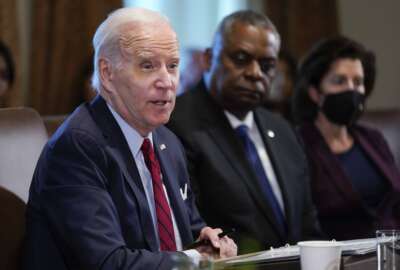Time to stick a fork in this bogged down procurement
"This is one of the lessons that NITAAC should have learned from industry comments before the final RFP ever went out," said Larry Allen.
The National Institutes of Health procurement arm issued requests for proposals on a multiple award contract three and a half years ago. The program, known as CIOSP4, still hasn’t made any awards. It’s still bogged down in protests. The program it replaces had been extended several times. My next guest says it’s time for NIH to start over. Federal sales and marketing consultant Larry Allen joined the Federal Drive with Tom Temin to discuss more.
Interview transcript:
Larry Allen It really is. We want CIOSP4 to succeed. There’s obviously some demand for a NITAAC contract offering by virtue of the fact that CIOSP3 keeps getting extended and then orders keep flowing through it. Unfortunately, at some point, you’re going to have to say it’s time for us to cut the cord. How long can you justify throwing good money after bad and making efforts on both the government and industry side to get CIOSP4 awarded? Sometimes you have to just say, we’re going to stop this and start fresh again. I think now is a particularly good time for that to happen. We keep having new protests filed claims court, and now NITAAC is getting a new director, and that’s an opportunity to take a new direction.
Tom Temin Yeah, for that matter, NIH is going to have a new director pretty soon. The whole organization. But there is precedent for this. A couple of years ago, the GSA canceled a project like this, a multiple award contract program that just got bogged down to the point where they abandon it and started all over.
Larry Allen That’s exactly right. This is the Alliant 2 it to small business contract that never got off the launching pad for the exact same reasons we’re seeing now in CIOSP4, Tom. Just an unending parade of protests. And GSA made the decision that turned out to be the correct one, to scrap it. Alliant 2 small business and come up with the standalone Polaris small business contract the GSA has just started making awards on in the last 60 days. So now that Polaris contract is going to be up and running on the short horizon and starting to actually do some business, ironically catapulting it ahead of CIOSP4, which it started after.
Tom Temin Right. And as you point out, CIOSP3 expires April 29. It’s unlikely that CIOSP4 could be awarded by then at this point, since there’s still protests going on.
Larry Allen Well, Tom, not only are there protests, but I think you have to look at it and you mentioned this at the introduction. The original RFP came out three and a half years ago. So we’re talking about our contract awards. If you look at it like if this were a contract for automobiles, it would be a contract today that would feature the very best automobiles from 2020 and 2021. And that’s not really where you want to be. The technology has changed in the IT industry. The solutions have changed. Three and a half years ago, nobody, for example, was really talking about AI in government. Certainly cloud has evolved since then as well, and we’ve got some new players in the market with some new innovative technologies. These are all reasons why I think it’s a good time to just say, this was a great effort, but sometimes, it’s like the end of a losing football season. You’ve got to cut your losses and draft up and get some free agents for the next year and put a better product out. And I think NITAAC could kind of take the lead from that example.
Tom Temin Of course, that would set them back another couple of years. Because it takes a good, solid two years to do these when they run smoothly. That’s true.
Larry Allen And I think that you have to make a business decision about whether or not it’s worth doing a CIOSP4. As I indicated earlier, there’s certainly interest in CIOSP3, but just because you had CIOSP3 doesn’t automatically mean number four gets to follow it or that number four looks structurally a lot like three. You could have the path that the Air Force took, for example, when it went to recompete its net sense contract. Instead of doing standalone contracts, they did a series of blanket purchase agreements based off of GSA schedule contracts. That was a significant reduction in the time needed to get the program in place, as well as reducing the likelihood for lengthy and successful protests.
Tom Temin We’re speaking with Larry Allen, president of Allen Federal Business Partners. And, of course, if you do stop and then start over again, you have to make sure the new effort is also not going to attract protests. In other words, if you’re putting a baby seal out there on the ice, and the polar bears come and rip it to pieces, you don’t want to start over again with another baby seal.
Larry Allen That’s very true. And I think this is one of the lessons that NITAAC should have learned from industry comments before the final RFP ever went out. And that is that there’s a real danger to doing a unified come one come all contract method. GSA was going to do that for its Oasis plus contract. And industry said, please don’t do that. Please have there be an unrestricted and then small business pods to go along with it. And GSA took that approach. I think NITAAC would be well-served by putting together a CIOSP4 small business like there is for CIOSP3, ironically. And then do an unrestricted CIOSP4 for everyone else. We’ve seen almost all of the protests here, Tom, come from small businesses and JVs as both government industry try to feel their way through changing regulations on how JV offers will be treated. There’s a strong argument, I think, to be made if you want to do a CIOSP4 that, you put them on two different tracks. You do a small business track and an unrestricted track. Otherwise you’re going to be right back where you are.
Tom Temin Well, let’s hope they’re listening to you over there on Executive Boulevard. In the meantime, contractors are warily, I guess, eyeing this Department of Government Efficiency. News keeps coming out about what they’re going to go after. Elon Musk and Vivek Ramaswamy. What are you hearing? What are contractors that you talked to, what are they worried about?
Larry Allen I can tell you that a lot of contractors were maybe a little bit slow to pick up on this, but they’re not slow anymore about it. A lot of companies are starting to ask questions about not only what it means for their federal customers, in terms of available budget, but what it means for they themselves being targeted as a group of companies that the perception could be over overcharging government. And so I think this is something that the industry, the government contracting industry really ought to justifiably pay attention to. We know that the rhetoric doesn’t always match the reality, but sometimes it comes close. And in order for the Department of Government Efficiency to be successful, it probably doesn’t need to match the rhetoric coming out. Even more modest headwinds or headways into government spending would be enough for industry to take up and stand up and take notice. So I think that’s exactly what they need to do right now. Contractors should have a voice in this. Remember there are three branches of government. You’ve got your elected officials in Congress that probably need to know just what the economic impact of all those government contracts are in their state and district. At the same time, do we want some efficiency in government? Sure we do. Is there room for efficiency? Absolutely. And I think that’s one way where contractors could actually benefit. So on the one hand, it might be a little concerning, my budgets are going to get cut. On the other hand, if this actually becomes an efficiency exercise as opposed to just a spending cut exercise, contractors could have an important role to play in that.
Tom Temin And the thing I haven’t heard anyone mention is the idea. And maybe Elon and Vivek aren’t aware of this, but there is an old rusty tool down there called the A-76 competitions, and those have been sort of dormant now for well, more than a decade.
Larry Allen Absolutely correct. And A-76 basically says that the government should not be competing with industry on non inherently governmental functions. So if you’ve got something that is not an actual statutory requirement of government, they need to take a hard look at that and see if their functions might compete with the private sector. And if so, A-76 says at minimum you have to do a cost benefit analysis to make sure that the government solution is actually worth it and not causing undue competition with the private sector. A-76 is a good tool. It doesn’t always get used, but I think to your point, it’s right there in the toolkit and it’s been effective before. And traditionally we’ve seen this as a tool being used by Republican administrations. Well, we’re about to have one of those again, along with the Republican Congress. You don’t always need new tools. Sometimes what you need to do is just clean off the ones that you have. And A-76 is a good one.
Copyright © 2025 Federal News Network. All rights reserved. This website is not intended for users located within the European Economic Area.
Tom Temin is host of the Federal Drive and has been providing insight on federal technology and management issues for more than 30 years.
Follow @tteminWFED






